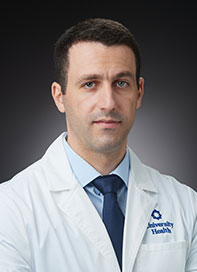Leaders in Minimally Invasive Endoscopic Procedures
Your doctor may recommend an advanced endoscopy (AE) procedure to help diagnose or treat a problem in your digestive tract. There are many benefits to getting an advanced endoscopic procedure instead of undergoing invasive surgery, it requires a shorter recovery and less time under anesthesia.
University Health offers a premiere endoscopy program that performs more leading-edge endoscopic procedures than any other medical facility in South Texas. Through our therapeutic advanced endoscopy services, we’re able to diagnose and treat GI disorders for hundreds of children and adults.
Innovative Therapeutic Endoscopy by Fellowship-Trained Physicians
You receive personalized care from some of the most talented endoscopists in the country – our group of gastrointestinal (GI) doctors are all fellowship-trained in advanced endoscopic techniques. Our medical team is well-known for achieving maximum outcomes with this less invasive form of treatment.
We provide exceptional health care for those who need medical treatment for common GI issues. Additionally, we perform advanced endoscopy to treat and manage the most complex conditions.
Our medical group is dedicated to improving the lives of those challenged with various gastrointestinal, biliary and pancreatic disorders.
Advanced Endoscopic Services for GI Conditions
We use advanced endoscopy to diagnose and treat conditions of the esophagus, stomach, small intestines, pancreas, gallbladder, bile duct, liver, colon and rectum.
Conditions We Treat
- Stones and strictures in the gallbladder, bile duct and pancreas
- Resection of complex polyps in the GI tract
- Difficulty swallowing including complex strictures in the GI tract
- Pancreatic tumors and cysts
- Barrett's esophagus
- Achalasia
- Zenker's diverticulum
- Post-surgical leaks
- Resection of early cancer in the GI tract
- Endoscopic therapy of obesity
If you want to request an appointment for any of the following AE services, please call 210-743-4324. Or email us with any questions you may have at AdvancedEndoscopyClinic@uhtx.com.
Advanced Endoscopy Techniques
ERCP is an advanced, minimally invasive procedure used to diagnose and treat conditions affecting the bile ducts, pancreas and gallbladder. Using a flexible, camera-equipped endoscope, our specialists can access these areas to remove blockages, treat strictures and perform specialized therapies.
Advanced Techniques in ERCP include:
- Laser lithotripsy
- Intraductal Radiofrequency Ablation (RFA)
- Pancreatoscopy
- Cholangioscopy
- Endoscopic papillectomy
ERCP combines diagnostic imaging and therapeutic interventions, reducing the need for surgery and leading to quicker recovery times. These techniques are often used for patients with bile duct stones, pancreatic disease, tumors or strictures that require precise, targeted treatment.
Endoscopic bariatric therapies are less invasive options compared to other bariatric surgeries. These therapies include:
- Endoscopic sleeve gastroplasty
- Endoscopic revision of bariatric surgery (TORe)
- Intragastric balloon placement for weight loss
These forms of therapy provide patients with significant weight loss without having to worry about many post-surgery complications. In over 80% of these procedures patients are able to return home on the same day without hospitalization.
The highly specialized extracorporeal shockwave lithotripsy (ESWL) procedure is for treating complex pancreatic stones. During the procedure, high-energy shock waves are directed at pancreatic stones from outside the body. These shock waves break the stones into smaller fragments, allowing them to pass naturally through the digestive tract.
ESWL is a non-invasive treatment option for pancreatic stones that are too large to pass on their own. The procedure is performed under sedation or anesthesia to ensure patient comfort.
An endoscopic ultrasound (EUS) is when your doctor passes an endoscope equipped with an ultrasound transducer into your stomach through your mouth. This allows your doctor to see your pancreas, liver, gallbladder, upper intestines and the areas around them.
EUS allows for high-resolution imaging of deep tissues and is commonly used to evaluate suspicious lesions, cysts or masses that may not be visible with standard imaging techniques. When needed, a fine-needle aspiration (FNA) or fine-needle biopsy (FNB) is performed during the procedure to obtain tissue samples for further examination and diagnosis.
EUS with FNA/FNB is valuable in diagnosing and staging cancers, assessing pancreatic diseases and evaluating abnormalities in the gastrointestinal tract.
During an interventional endoscopic ultrasound (EUS) procedure, our specialists use a specially designed endoscope equipped with an ultrasound probe. This is used to perform advanced therapeutic interventions within the gastrointestinal tract and surrounding structures. An interventional EUS is a minimally invasive approach that allows for precise treatment of complex conditions without the need for traditional surgery.
Interventional EUS is used for a variety of procedures, including:
- Pancreatic fluid collection drainage
- Celiac plexus block
- Transmural bile duct drainage
- Fiducial placement
- Gastric variceal coiling
Interventional EUS provides an effective alternative to surgery for many patients, offering faster recovery times and fewer complications.
An endoscopic mucosal resection is performed with a long, thin tube with a light and camera attached to it. Your doctor passes the endoscope down your throat to carefully examine one or several areas of your upper digestive tract including your esophagus, stomach or the upper part of your small intestine. If your colon is being examined, then the endoscope is passed through your anus.
This advanced endoscopic procedure is typically used to treat cancer and to determine if it has spread. As an example, it can help your doctor determine if cancer has spread to tissue underneath the digestive tract lining. An EMR is also used to access small pieces of tissue for analysis to help a doctor make an initial diagnosis.
During a complex esophageal stricture dilation procedure, an endoscope is used to evaluate and widen narrowed sections of the esophagus that cause difficulty swallowing (dysphagia). Esophageal strictures can develop due to conditions such as chronic acid reflux, scar tissue from surgery or radiation therapy or certain diseases affecting the esophagus.
This minimally invasive procedure is performed under sedation to ensure comfort and is often repeated as needed to maintain esophageal patency.
During an endoscopic suturing procedure, your provider will use a special endoscope with a suturing device in order to place stitches inside the stomach or intestines, without the need for traditional surgery.
This minimally invasive technique is used for a variety of therapeutic applications, including closing defects, securing stents, managing fistulas and revising previous bariatric surgeries.
A peroral endoscopic myotomy (POEM) is typically performed for patients who have Achalasia, a type of swallowing disorder. The POEM procedure can also be beneficial to patients with various spastic esophageal conditions, unresolved heartburn, weight loss issues or for those who have difficulty digesting food.
A bendable endoscope is passed through the mouth and into the throat. A small opening is made into the deepest layer of the esophagus. The endoscope is then carefully guided down the length of the esophagus.
The gastroenterologist cuts the muscle fibers of the lower esophageal sphincter allowing the non-functioning part of the esophagus to relax and allow food to be digested more easily and to move forward into the stomach.
During a Barrett’s endoscopic therapy procedure, radiofrequency ablation (RFA) is used to treat Barrett’s esophagus. This is a condition in which the normal lining of the esophagus is replaced with abnormal precancerous cells due to chronic acid reflux (GERD). If left untreated, Barrett’s esophagus can increase the risk of esophageal cancer.
RFA is a minimally invasive treatment that uses controlled thermal energy to precisely target and remove the abnormal tissue while preserving the healthy esophageal lining.
The procedure is performed under sedation and does not require surgery. Most patients need multiple treatment sessions for the best results. After the procedure, some may experience a mild sore throat or discomfort, but most can return to normal activities within a day.
An endoscopic submucosal dissection is used to remove polyps or deep tumors from the gastrointestinal tract. Once the tumor or growth is located, the layer beneath it (the submucosa) is injected with a solution which allows your gastroenterologist to gently separate it from the muscle wall.
By doing this, it helps to ensure that tissue surrounding the area won’t be damaged. An electrosurgical knife with a high-frequency current is used to remove the tumor and surrounding tissue. This high-tech knife is also used to stop any bleeding that may occur after the tumor is cut away.
Patients who have a complicated medical condition can often be helped with this advanced endoscopic technique and avoid having an open surgery or laparoscopic procedure. The benefit is that you recover more quickly with less pain.
This is a newer procedure that takes longer but for many patients provides better long-term outcomes. Only a few centers in the country provide this type of endoscopic procedure because it requires such a high-degree of proficiency.
Device-assisted enteroscopy is a minimally invasive procedure used to examine and treat problems in the small intestine. It is helpful for diagnosing and treating conditions that are hard to reach with regular endoscopy.
During the procedure, a thin, flexible tube with a camera (endoscope) is carefully guided through the small intestine. This special endoscope is equipped with a balloon system that inflates and deflates to help move the scope through the twists and turns of the intestines.
A double-balloon or single-balloon enteroscopy allows doctors to reach areas that are usually difficult to access.
Endoscopic wound vacuum placement is a specialized therapy and is a minimally invasive procedure used to help heal difficult wounds inside the digestive tract. It is often used for patients who have leaks, holes (perforations) or other damage in areas like the esophagus, stomach or intestines.
During the procedure, a thin, flexible tube with a camera (endoscope) is gently guided into the digestive tract. A small sponge connected to a vacuum system is placed over the wound. This special system removes extra fluid and bacteria while gently pulling the tissues together to help them heal faster. It also improves blood flow, which helps the body repair itself.



